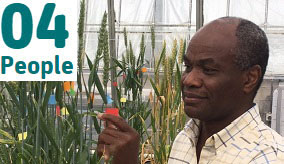02 Research

Passing gas unlocks key to fuel of the future
Hydrogen is a clean fuel that has an array of exciting applications, from powering vehicle fuel cells to industrial processes. But both sourcing and extracting hydrogen to get it to market had proved difficult - until now. Our scientists have developed a special membrane that allows hydrogen to be transported in the form of ammonia (which is already being traded globally), and then passed back through as hydrogen at the point of use. This means we could potentially transport Australian-made hydrogen to the world.












